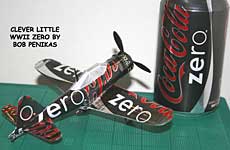
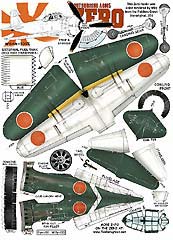
Zero - $$5.95
The pre-series A6M2 Zero became known in 1940-41, when the fighter destroyed 266 confirmed aircraft in China. At the time of Pearl Harbor, there were 420 Zeros active in the Pacific. The carrier-borne Model 21 was the type encountered by the Americans, often much further from its carriers than expected, with a mission range of over 1600 statute miles.
WWII Japanese Mitsubishi A6M Reisen Zero
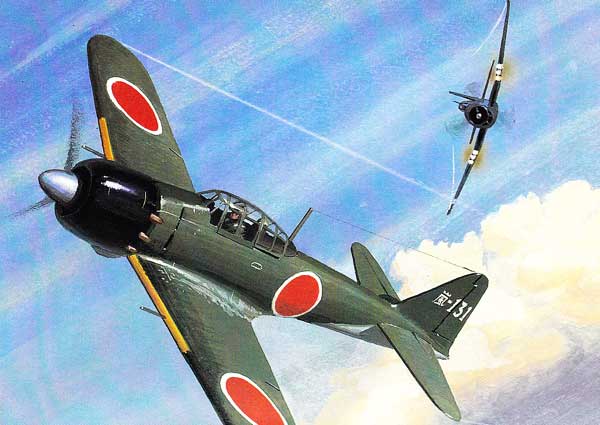
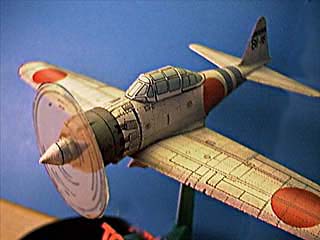 This little Japanese Fighter was a real threat to Allied forces in the Pacific. With a little care you can glue clear plastic to the back of the canopy piece for a real neat effect. The markings of the model chosen are those of the first wave of Pearl Harbor attackers and certainly rounds out our WWII series of Top Ten Fighters.
This little Japanese Fighter was a real threat to Allied forces in the Pacific. With a little care you can glue clear plastic to the back of the canopy piece for a real neat effect. The markings of the model chosen are those of the first wave of Pearl Harbor attackers and certainly rounds out our WWII series of Top Ten Fighters.
A6M2 of fighter complement of carrier Hiryu (signified by tail coding "BII") during attack on Pearl Harbor, December 1941. Cobalt blue tail band indicated flight leader and twin fuselage bands signified second carrier in 2nd Carrier Division (1 st Air Fleet).
The A6M Reisen (Zero Fighter) was unique among WWII combat aircraft in creating a myth. The Allies credited the Reisen with almost mystical powers of maneuver, fostering a myth of Japanese aerial invincibility. Everything to the Japanese that the Spitfire was to the British, the Reisen was a lightly constructed but extraordinarily capable fighter first flown on 1 April 1939, series aircraft entering service early in 1941. Excluding float-equipped and training versions a total of 10,449 Reisen's was manufactured.


 |
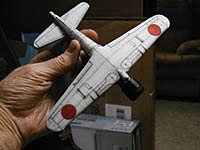 |
Here are photos of Fiddlers Zero patterns used with Coke's new Zero. How could I resist? The Quick Grip contact cement is working quite well. I hope Coke is producing larger size cans as these small ones are quite limiting. The fuselage took some finagling. Bob |
|
 |
|
Reisen A6M Zero-Sen by Mitsubishi
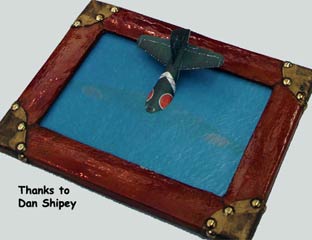
I threw some layers of transparency down on a water texture and had a bit
of sunken Zeke under the waves. I just hopped into my Pacific Fighters simulator
and took a photo of the Zero at the right angle. The frame I borrowed from
my display of Russian aircraft stamps. RM Dan

When the Japanese Navy struck at Pearl Harbor on Sunday, 7 December 1941, the Americans already possessed files on the A6M in the form of detailed combat reports from Colonel Claire Chennault in far-off Chungking, China. Nobody had bothered to disseminate the information, and for a second time this agile and well armed fighter caused a great shock and made mincemeat of the motley collection of aircraft that opposed it. In six months the Sentais (fighter groups) equipped with the A6M had so dominated the sky that the Imperial forces had conquered over 12 million square miles, a far greater area than had ever previously been overrun by one nation. The A6M kept appearing in places where Japanese fighters had been judged 'impossible', sometimes almost 1,000 miles from the nearest advanced Japanese airbase or carrier. In combat it could outmaneuver practically every Allied fighter, and its firepower was also superior.
Of course the A6M was not really miraculous. Back in 1937 the British Gloster company had flown a prototype fighter that almost precisely paralleled the A6M in size, shape, weight, power and performance - and it was not even accepted for the RAF. At that time Horikoshi was making the first drawings of his new fighter to try to meet a newly issued Imperial Navy specification that called for a shipboard fighter with the maneuverability of his earlier A5M (one of the most agile aircraft ever built) despite the burden of two 20-mm cannon as well as the two machine-guns carried by the A5M, two 132-lb bombs, full radio, an engine to give a speed of 311 mph and an endurance of eight hours with a drop tank. (It should be noted that the Imperial Navy measured speeds in knots, so that required of the new fighter was 270 knots.)


|
Known to the Japanese as the Reisen(Zero fighter) and to the Allies as the "Zeke", the A6M was one of the decisive weapons of WWII. The prototype flew in April 1939, and the production up to the end of the war amounted to some 10,450 fighters. The A6M2 entered service in summer of 1940, and for the first time a carrier fighter offered performance equal to or better than that of land based fighters. This is a model of one of the actual planes that attacked Pearl Harbor on the "day of infamy". Overall scheme was light gray with blue signifying the Second Air Division, the two stripes indicating the second ship. The tail code also meant the same (B=2ndAD, II=2nd ship)
Construction Tips! This is another model that the nose fits over the fuselage (see Error alert on left). The ZERO fuselage is fairly rounded and needs no extra effort to shape. Also, like our other WWII models, the wing fairing's are bent outward before the wing is attached. This is the prettiest model of the series and you really should buy a few dozen or so to recreate the devastating attack on Pearl Harbor on Sunday December 7, 1941 |
Toughest part of the model for me was gluing on the individual prop blades. I double up the blades before coloring the reverse side, but keeping them aligned while the glue dried was a bear. The spinner went together nicely, especially when I stuffed the inside with tissue paper to help hold the rounded shape. I did make a small round insert for the back of the spinner -- it made it real easy to then insert a toothpick into the back of the spinner and then into the front of the engine disc for a propeller that spins. I had to cut the engine disc down a bit because it seemed a little too big for the front ring and cowling. Flat tooth picks between the folded main landing gear struts fit perfectly and added a lot of stability when a small piece at the top is popped into a hole drilled into the underside of the wing |

The result was wholly conventional, with stressed-skin structure, split flaps, wide-track inward-retracting landing gear and a radial engine driving a variable-pitch propeller. After some argument a sliding canopy was added over the cockpit, and the newly demanded cannon (Type 99 Model 1, derived from the Oerlikon) were fitted in the wings, outboard of the propeller disc. Its designation was naturally A6M,A for carrier-based fighter and 6M for the sixth such type by Mitsubishi. It's popular name was Reisen (Reisen, zero fighter), from the Japanese year 2600 (1940 A.D.). The first A6M1, with a 780-hp Mitsubishi Zuisei 13 engine, flew at Kagamigahara on 1 April1939, and showed outstanding qualities except in its speed of 304 mph which just missed the target. A constant-speed propeller gave an increase in all-round performance, but more power was needed and on 28 December 1939 the third prototype, designated A6M2, flew with the 925-hp Nakajima Sakae 12. This prototype exceeded all expectations, and by July1940 the A6M2 had been cleared for production. It was decided to send 15 to China to test them in action with the 12th Rengo Kokutai. They got their first victim on 13 September 1940, and though two A6M2s were shot down by ground fire their air combat record was a remarkable 99 victories for no losses before they were redeployed for the war in the Pacific.
From the 22nd A6M2 the rear spar was strengthened, and from the 65th the outermost 20 in of the wings was hinged to fold upwards manually. In June 1941 the A6M3 had these tips omitted, and with the 1,130-hp Sakae 21 engine offered higher speed and more rapid roll, though turn radius was slightly worsened. At Pearl Harbor the Imperial Navy had 328 A6Ms embarked aboard carriers, and from the start they achieved complete mastery over the Curtiss P-40, Curtiss-Wright CW-21A, Brewster Buffalo, Hawker Hurricane I and other opponents. For example the hapless Buffaloes of the RAE, RAAF, RNZAF and Dutch East Indies were so out flown their 12.7-mm guns were replaced by 7.62-mm weapons, ammunition was cut by half and fuel by more than one-third, and still they could not bring their guns to bear over the more agile and much harder-hitting A6M.
 Not knowing what the fighter was called, the Allies named it
'Ben' then 'Ray' and finally 'Zeke'. The clipped-wing model was
called 'Hap', until someone recalled that that was the nickname
of the USAAF Chief of Staff, General H. H. Arnold, when it became
'Hamp'. When the type was recognized as merely another version
of the 'Zeke' it was called 'Zeke 32'. But desperate attempts
to gather even pieces of the almost supernatural fighter proved
elusive, until suddenly US troops found a perfect A6M2 in the
Aleutians. Petty Officer Koga had taken off from the carrier Ryujo
on 3 June to attack Dutch Harbor, but two bullets had severed
the fuel supply pipe and he had glided in to the uninhabited island
of Akutan. Landing on marshy ground, the A6M had somersaulted
and Koga had broken his neck. The valuable prize was soon on test
at NAS North Island, San Diego, where the myths were blown away
and the A6M's numerous shortcomings revealed.
Not knowing what the fighter was called, the Allies named it
'Ben' then 'Ray' and finally 'Zeke'. The clipped-wing model was
called 'Hap', until someone recalled that that was the nickname
of the USAAF Chief of Staff, General H. H. Arnold, when it became
'Hamp'. When the type was recognized as merely another version
of the 'Zeke' it was called 'Zeke 32'. But desperate attempts
to gather even pieces of the almost supernatural fighter proved
elusive, until suddenly US troops found a perfect A6M2 in the
Aleutians. Petty Officer Koga had taken off from the carrier Ryujo
on 3 June to attack Dutch Harbor, but two bullets had severed
the fuel supply pipe and he had glided in to the uninhabited island
of Akutan. Landing on marshy ground, the A6M had somersaulted
and Koga had broken his neck. The valuable prize was soon on test
at NAS North Island, San Diego, where the myths were blown away
and the A6M's numerous shortcomings revealed.
For one thing, it is possible to do only so much on 1,130-hp. The A6M airframe was lightly built, and the vital parts were by Western standards deficient in armour. Tactics were worked out to gain superiority in combat, but at least as important was the first flight, on the other side of the United States, of the first Grumman F6F Hellcat in June 1942. Larger and heavier than the A6M, this US Navy fighter had a 2,000-hp engine: this enabled it to be stronger, tougher and better protected and yet outfight the A6M in a dogfight. Another US Navy and Marines fighter, the bent-wing Vought F4U Corsair, was even more formidable, and the US Army's P-38 was not only much faster but could stay with an A6M at all heights above 10,000 ft despite being much larger. And all these Allied fighters had firepower that could actually cause an A6M to break up into pieces.
Seaplane variant
In autumn 1940 an Imperial Navy specification called for a fighter seaplane to operate over isolated beachheads and beyond the range even of the A6M, and, while the powerful Kawanishi NiKi (which in turn was eventually to lead to a formidable land-based fighter) was developed, the Nakajima company was instructed to build a seaplane A6M. The resulting A6M2-N flew on the day of Pearl Harbor and was soon in action. Though as neat a conversion as could be imagined, it was inevitably inferior to Allied fighters and though 327 were delivered, the last in September 1943, they did not achieve very much. Another off-mainstream variant was the tandem dual control A6M2-K advanced trainer, which was the responsibility of the 21st Naval Air Arsenal, at Sasebo. Not even started until 1943, the first two-seater flew in November that year, and eventually 515 were built in two versions, with cannon and landing-gear doors removed to save weight. At Mitsubishi, Horikoshi had from 1940 pressed for a successor to the A6M, with his company's 2,200-hp MK9 engine, but this was repeatedly delayed, and the old A6M had to be kept in production, both at the parent firm and (in even greater numbers) by Nakajima.
A 1943 attempt to improve performance at medium and high altitudes came to nothing: the 1st Air Technical Arsenal at Yokosuka fitted two A6M2s with turbo charged Sakae engines, but these were gravely unreliable. Nothing could be done but hastily to contrive an interim improved version, the A6M5; and, like so many hasty interim fighters, such as the Spitfire Mk IX, it was made in greater numbers than all the others. The chief modification was a new wing, with fixed rounded tips of 36 ft in span and thicker skins to enable the new version to dive at much higher speeds; previously limitations in diving speed had made the Zero easy to catch. This added 416 lb to the weight, and did nothing for maneuverability, but a slight improvement in performance resulted from fitting individual or paired exhaust pipes to the 14 cylinders with nozzles arranged to give forward thrust at full power. Together with a careful detail refinement all this added up to a significantly better fighter, and when it reached combat units in numbers in the autumn of 1943, the A6M5 did something to redress the balance which had rather quickly tilted towards the US Navy with the entry to combat duty of the F6F Hellcat.
 A 1943 attempt to improve performance at medium and high altitudes
came to nothing: the 1st Air Technical Arsenal at Yokosuka fled
two A6M2s with turbo charged Sakae engines, but these were gravely
unreliable. Nothing could be done but hastily to contrive an interim
improved version, the A6M5; and, like so many hasty interim fighters,
such as the Spitfire Mk IX, it was made in greater numbers than
all the others. The chief modification was a new wing, with fixed
rounded tips of 36 ft span and thicker skins to enable
the new version to dive at much higher speeds; previously limitations
in diving speed had made the Zero easy to catch. This added 416 lb to the weight, and did nothing for maneuverability,
but a slight improvement in performance resulted from fitting
individual or paired exhaust pipes to the 14 cylinders with nozzles
arranged to give forward thrust at full power. Together with a
careful detail refinement all this added up to a significantly
better fighter, and when it reached combat units in numbers in
the autumn of 1943, the A6M5 did something to redress the balance
which had rather quickly tilted towards the US Navy with the entry
to combat duty of the F6F Hellcat.
A 1943 attempt to improve performance at medium and high altitudes
came to nothing: the 1st Air Technical Arsenal at Yokosuka fled
two A6M2s with turbo charged Sakae engines, but these were gravely
unreliable. Nothing could be done but hastily to contrive an interim
improved version, the A6M5; and, like so many hasty interim fighters,
such as the Spitfire Mk IX, it was made in greater numbers than
all the others. The chief modification was a new wing, with fixed
rounded tips of 36 ft span and thicker skins to enable
the new version to dive at much higher speeds; previously limitations
in diving speed had made the Zero easy to catch. This added 416 lb to the weight, and did nothing for maneuverability,
but a slight improvement in performance resulted from fitting
individual or paired exhaust pipes to the 14 cylinders with nozzles
arranged to give forward thrust at full power. Together with a
careful detail refinement all this added up to a significantly
better fighter, and when it reached combat units in numbers in
the autumn of 1943, the A6M5 did something to redress the balance
which had rather quickly tilted towards the US Navy with the entry
to combat duty of the F6F Hellcat.
Sheer lack of power in the Japanese fighter meant that it was far behind its opponent in armour and firepower, and in its ability to withstand battle damage. Lack of power was also the reason for the rate of climb falling off, compared with the lighter earlier versions, to levels below that of the heavyweight F6F. Even with thicker wing skins the A6M could not escape by diving away; in fact faced with an F6F, F4U or Spitfire Mk VIII there was no way an A6M pilot could survive except by exceptional flying, amazing luck or shooting down his opponent. And, as 1943 proceeded, this became more and more difficult.
Fortune turns
For one thing, the Allied fighters were not only getting dramatically superior but they were arriving in floods that completely overwhelmed the Japanese. Even in 1941-2 the Zeros had been outnumbered, but they had been deployed in concentrated groups that gained total local control and inflicted catastrophic losses, whilst the motley collections of Allied machines were scattered and often under no central direction. By 1943 the US Navy, US Marines, US Army Air Force and British Commonwealth forces were all coordinated and enjoyed numerical superiority everywhere.
Not least of the Imperial Navy's problems was its rapid attrition in aircraft-carriers. Even as early as the Battle of Midway in June 1942 - often regarded as the start of the turnaround in fortunes in the Pacific war - the great carriers Akagi, Hityu, Kaga and Sotyu were all sunk; the light carrier Shoho had been sunk a month earlier, and Ryujo went to the bottom in August 1942. These crippling losses in seagoing air power gravely restricted the Imperial Navy's ability ever again to achieve command of the sky, at any place or at any time.
There was yet a further serious problem which had as much effect as all other factors combined. In air combat the man is every bit as important as the machine. Even flying an inferior aircraft, in the rather primitive days of World War II, a brilliant and courageous pilot could often run up strings of victories over opponents flying faster or better-armed aircraft. In 1941 the Imperial Navy pilots had been well trained, and were aggressive and in most cases experienced. Many had seen a year or more of actual fighting in China or against the USSR, and in their hands a Zero was deadly. By 1943 hardly any of these pilots were still alive, and their replacements were by comparison ineffectual. The home-based training program was wholly inadequate, and by autumn 1944 the once-dominant Sentais were being reorganized into kamikaze (suicide) squads in a desperate attempt to stem the tide of Allied advance.
 |
Improved armament
Throughout the war the need for long range had been manifest, but whereas at the start the A6M had been supreme in this regard, especially after its experienced pilots had learned correct long-range cruise techniques at high boost pressure but low crankshaft revolutions, by 1943 the Sakae 21 had resulted in smaller fuselage tankage (in part rectified by adding two small 45-litre/9.9-Imp gal tanks in the outer wings) and appreciably higher fuel consumption. Crucial need to keep weight down precluded heavier armament, though the Type 99 cannon was improved through several versions with a longer barrel and higher muzzle velocity, rate of fire increased from 490 to an eventual 750 rounds per minute, and a 125-round belt in place of the original 100-round drum. The greater muzzle velocity had the possibly important effect of extending the effective range (typically from 12,624ft to 3,281ft, this was one factor where the A6M could have scored over the US fighters that relied on the 12.7-mm (0.5-in) Browning.
In practice, Japanese pilots lacked the shooting skill to open fire accurately at long ranges, and at normal air-combat distances the much more rapid rate of strikes from the typical US armament of six 12.7-mm (0.5-in) guns proved decisive. When fitted with the long-barrel belt-fed cannon the A6M5 became the A6M5a, available from production in the spring of 1944. Within weeks the A6M5b, was coming off the line, and this partly rectified one of the type's gravest shortcomings, lack of protection. The A6M5b had improved armour, automatic fire-extinguishers in the main fuel tanks and a slab of bullet-proof glass behind the windscreen. A small increase in firepower resulted from substituting the 13.2-mm Type 3 heavy machine-gun for one of the rifle caliber weapons ahead of the windscreen.
Hundreds of A6M5a and A6M5b fighters took part in the great battles around the Marianas and Philippines in the summer of 1944, but the first major engagement of the A6M5b was such a slaughter at the hands of F6Fs that US pilots called it 'The Marianas Turkey Shoot'. To a considerable degree this was because of the superior skill of the American pilots.

Desperate Measures
 This debacle spurred the Imperial Navy into a further
desperate attempt to improve the A6M, a requirement being issued
for racks for underwing rockets, extra 13.2-mm guns outboard
of the cannon, a large additional fuel tank behind the cockpit
and a fully armored pilot seat. If the A6M had needed extra
power beforehand, it doubly needed it now, but permission to
fit a larger engine was not granted. After building 93 with
the improvements demanded Mitsubishi did receive some Sakae
31 engines, with extra power gained by injecting water/methanol
to prevent detonation at full throttle, but most of these engines
were retained by the maker, Nakajima, which went into production
with the resulting A6M6c at the end of 1944. This was the final
model of Reisen to see action, and it could not do more than
earlier models to hold back the overwhelming advance of the
Allied land, sea and air forces towards Japan.
This debacle spurred the Imperial Navy into a further
desperate attempt to improve the A6M, a requirement being issued
for racks for underwing rockets, extra 13.2-mm guns outboard
of the cannon, a large additional fuel tank behind the cockpit
and a fully armored pilot seat. If the A6M had needed extra
power beforehand, it doubly needed it now, but permission to
fit a larger engine was not granted. After building 93 with
the improvements demanded Mitsubishi did receive some Sakae
31 engines, with extra power gained by injecting water/methanol
to prevent detonation at full throttle, but most of these engines
were retained by the maker, Nakajima, which went into production
with the resulting A6M6c at the end of 1944. This was the final
model of Reisen to see action, and it could not do more than
earlier models to hold back the overwhelming advance of the
Allied land, sea and air forces towards Japan.
The A6M7 was equipped to carry a 551-lb bomb as well as outer-wing drop tanks. The A6M8 at last had a more powerful engine, the 1,560-hp Mitsubishi Kinsei 62, resulting in a slightly larger cowling and removal of the machine-guns previously fitted above it. This did not fly until May 1945 and no production aircraft could be completed. There were many experimental forms of armament and special equipment fits, but by far the most important were the kamikaze lash-ups with, usually, a 551-lb bomb hung on the rack normally used for the centerline drop tank.
Total production of the A6M was 10,449 (3,879 by Mitsubishi and 6,570 by Nakajima), and these were complemented by 327 Nakajima-built A6M2-Ns, and 515 A6M2-Ks and A6MS-Ks (236 by DaiNijuichi Kaigun Kokusho and 279 by Hitachi Kokuki KK).


 |
| Cockpit of the Misubishi A6M Zero. |
Specifications
 |
Length: 29 ft 9 in Bombs: |
 |
||
| A: Zeroes had three fuel tanks, one in each wing root, and one just in front of the pilot None were self-sealing, so a minor hit could mean destruction of craft and pilot. | B: The A6M5c carried a 20-mm cannon inboard and a 13.2-mm heavy machine gun outboard in each wing. | C: The Zero wing had combat flaps fitted, which helped give the aircraft its phenomenal maneuverability. |
 |
||
| A: The Sakae radial was not that powerful when compared with the huge American engines, but was fine for this small and light machine. | B: The biggest weakness of the Zero was a total lack of armor plate. The A6M5 introduced armored glass in the cockpit, but the fighter was still horribly vulnerable. | C: Although it had space for two, the A6M5c usually carried a single heavy machine gun over the engine. |
| D: Like every good carrier plane, the Zero had a wide, strong and stable undercarriage. | E: The Zero had exceptionally long range, and a drop tank extended its endurance even further. But lack of self-sealing fuel tanks was a grave tactical weakness. | F:The rear fuselage contained a large canvas flotation bag in case the airplane ditched. |





